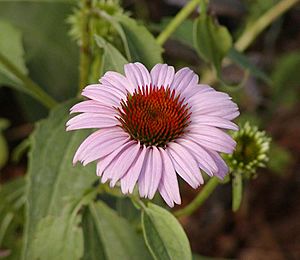Asterales facts for kids
Quick facts for kids Asterales |
|
|---|---|
 |
|
| Echinacea purpurea | |
| Scientific classification | |
| Kingdom: | |
| Division: | |
| Class: | |
| Order: |
Asterales Lindl. (1833)
|
| Families | |
|
See text |
|
The Asterales are a very important group of flowering plants. You might know some of them, like sunflowers, daisies, and thistles. This group includes the huge Asteraceae family, which is also called the composite family, and many other related plant families.
What are Asterales?
The Asterales are an "order" in the world of plants. Think of it like a big family tree for plants. An order is a group of related plant families that share common features. These plants usually have flowers that are arranged in a special way.
Key Features of Asterales
Most plants in the Asterales order share some cool characteristics:
- Flower Structure: Their flowers often grow in dense clusters, making one big "flower head" that looks like a single flower. A daisy or a sunflower is a great example of this. What looks like one flower is actually many tiny flowers grouped together!
- Pollen: They have a special way their pollen is released.
- Chemicals: Many of these plants produce certain chemicals that help protect them from insects or diseases.
Families of Asterales
Within the Asterales order, there are several different families. Each family contains plants that are more closely related to each other. Here are some of the main families in this order:
- Alseuosmiaceae
- Argophyllaceae
- Asteraceae - This is the largest family in the Asterales. It includes all the daisies, sunflowers, thistles, and many other popular garden and wild flowers.
- Calyceraceae
- Campanulaceae (including Lobeliaceae) - This family includes beautiful Bellflowers, known for their bell-shaped flowers.
- Goodeniaceae (including Brunoniaceae)
- Menyanthaceae
- Pentaphragmaceae
- Phellinaceae
- Rousseaceae (including Carpodetaceae)
- Stylidiaceae (also Donatiaceae)
See Also
 In Spanish: Asterales para niños
In Spanish: Asterales para niños

